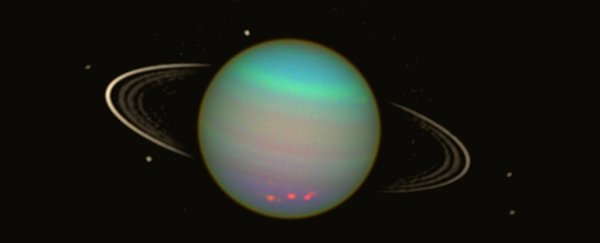Uranus, far from Earth in the darker region of the Solar System's planetary reach, isn't alone. It's accompanied by a retinue of moons - 27, to be precise. Far and dim, these moons are difficult to study, but astronomers have made an accidental discovery while observing Uranus.
According to infrared images of the five main moons of Uranus, their composition is closer to that of dwarf planets like Pluto and Haumea - compact, rocky objects with an icy crust - than the more fluffy composition of the smaller Uranian moons.
Uranus orbits the Sun at an average distance around 20 times that of Earth. We haven't sent many spacecraft out that far - only NASA's Voyager 2 spacecraft has had a close encounter with Uranus, back in 1986 on its way to the edge of the Solar System and beyond.
Apart from those Voyager 2 observations, our study of the planet and its satellites has relied on telescopes closer to home - on Earth, and in Earth's orbital vicinity. That makes the moons very challenging to see; they're much smaller and reflect much less sunlight than Uranus, so they get outshone to the point of invisibility.
"The moons, which are between 500 and 7,400 times fainter, are at such a small distance from Uranus that they merge with the similarly bright artifacts," said astronomer Gábor Marton of Konkoly Observatory in Hungary. "Only the brightest moons, Titania and Oberon, stand out a little from the surrounding glare."
Which makes an accidental detection of the five moons by the European Space Agency's Herschel Space Observatory, in operation between 2009 and 2013 to study the galaxy in infrared radiation, quite delightful.
"Actually, we carried out the observations to measure the influence of very bright infrared sources such as Uranus on the camera detector," said astronomer Ulrich Klaas of the Max Planck Institute for Astronomy in Germany
"We discovered the moons only by chance as additional nodes in the planet's extremely bright signal."
 From left to right: Miranda, Ariel, Umbriel, Titania and Oberon, imaged by Voyager 2 in 1986. (NASA/JPL/MPIA)
From left to right: Miranda, Ariel, Umbriel, Titania and Oberon, imaged by Voyager 2 in 1986. (NASA/JPL/MPIA)
The five main moons of Uranus are, in descending order of size, Titania, Oberon, Umbriel, Ariel, and Miranda. Voyager 2 revealed that all five have a rounded shape that indicates they have achieved hydrostatic equilibrium - that is, enough mass to develop a symmetrical, rounded shape under their own gravity. And they seem to be composed of rock and ice.
That's not unusual for objects that far from the Sun. Even when warmed by the Sun, the temperatures of Uranus and its moons only get as high as between 60 and 80 Kelvin (-213 to -193 degrees Celsius, or -350 to -315 degrees Fahrenheit) at the surface. Pluto is very rocky and icy.
But how that rock and ice is put together matters. The eccentric orbits of Uranus' smaller, irregular, asymmetrical moons suggests they have a composition very similar to the rocky bodies in the Kuiper Belt out beyond Neptune, the trans-Neptunian objects. These are only loosely bound together, and quite small.
"This would also fit with the speculations about the origin of the irregular moons," said astrophysicist Thomas Müller of the Max Planck Institute for Extraterrestrial Physics in Germany. "Because of their chaotic orbits, it is assumed that they were captured by the Uranian system only at a later date."
Usually, the five main moons, which orbit Uranus' equator, would be difficult to see. Uranus has a weird orientation, tipped on its side with respect to its orbital plane around the Sun, so its equator is often in shadow.
 (T. Müller [HdA]/Ö. H. Detre et al./MPIA)
(T. Müller [HdA]/Ö. H. Detre et al./MPIA)
During the team's observations of Uranus between 2010 and 2012, however, the equator was in view of the telescope and in the sunlight. And when the team subtracted Uranus from the data using a specially developed algorithm, something amazing emerged.
"We were all surprised when four moons clearly appeared on the images, and we could even detect Miranda, the smallest and innermost of the five largest Uranian moons," said astronomer Örs H. Detre of the Max Planck Institute for Astronomy.
This enabled the team to measure how well heat from the Sun was retained in the surfaces of the moon as that surface rotated away into night. These surfaces, it turned out, retained heat quite well, cooling down relatively slowly.
It was a familiar heat retention and cooling profile - the closest match is dwarf planets like Pluto and Haumea, with their dense rocky bodies and ice-encrusted surfaces. This suggests that Titania, Oberon, Umbriel, Ariel and Miranda are built the same way - although the exact chemical composition of the rock and the ice thereon is yet to be determined.
The finding could mean that sending a probe to the ice giants could help us learn more about more distant objects, even farther out in the dim reaches of the Kuiper Belt. But it also shows the value of looking right under our noses.
"The result demonstrates that we don't always need elaborate planetary space missions to gain new insights into the Solar System," said astronomer Hendrik Linz of the Max Planck Institute for Astronomy.
"In addition, the new algorithm could be applied to further observations which have been collected in large numbers in the electronic data archive of the European Space Agency ESA. Who knows what surprise is still waiting for us there?"
The research has been published in Astronomy & Astrophysics.
